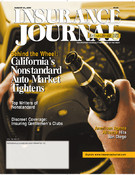Q. Who is the single largest investor in California’s $1.2-trillion economy?
A. The insurance industry. Comprised of 827 property/casualty companies and 579 life/health companies, the insurance industry has a 1998 total of $463.4 billion in total investments.
This is one of the findings in a recently released report, the California Insurance Economic Impact Report. According to the three associations that collaborated on the publication-the Association of California Insurance Companies (ACIC), the Personal Insurance Federation of California (PIFC) and the Association of California Life and Health Insurance Companies (ACLHIC)- the report is the first of its kind.
Jerry Davies, director of communications for PIFC, explained that about a year ago, as he was working on an economic impact look at the property and casualty side, he became intrigued with the idea of including everyone by adding the life and health.
“So I talked to Tony Quinn [consultant for ACLHIC] and Bill Packer [vice president of ACIC],” Davies said. “We put our heads together and came up with this booklet.”
The basic aim of the collaboration was twofold. The first goal was to give the legislature an idea of exactly what the insurance industry is and the extent of the contributions it makes to the economy of the state of California. The second goal was to try to disseminate some of that information to the public, and in doing so, try to address some of the misconceptions that may exist.
On the investment side- which includes government securities, corporate stocks and bonds, mortgage loans and real estate holdings-p/c companies were estimated to have invested $172.9 billion of the industry total. This included $170.3 billion in stock and bond investments and $2.6 million in real property and mortgages.
The report also indicated that in excess of $15 billion in local and municipal bonds for community projects was held by the industry as a whole. Davies underscored the importance of the fact that the investments of the p/c industry have to be more liquid than those of life and health.
“You’re not going to see [the p/c industry] investing in long-term, non-takeout types of investments where they have to put their money in and leave it there for a certain number of years no matter what in order to get a return,” Davies said. “They need their money instantly when a disaster strikes.”
Davies added that this contrasts with how life insurance companies invest and explains why the p/c industry opposes bills in the legislature which discuss mandating p/c companies to invest a certain percentage of their underwriting each year in inner city projects or community development.
“What they’re discussing at the state level would be long-term investments in a community,” Davies said. “[It’s] a good idea, but if it has to be, let’s say, for a period of 10 years, and we have an earthquake in three years…if they can’t get their money out right away, then you’re looking at some financial instability that’s threatening the actual existence of the company.”
Total insurance investments supporting the job-producing private sector economy were also impressive, adding up to $264 billion. Davis noted that “every company in the state has vendors that they support big time, in printing and supplies, furniture, office equipment, moving expenses and things like that.”
Another striking feature of the report was that in 1998, a total of $1.2 billion in premium taxes was collected by the state from 1,622 p/c, life, title and ocean marine companies. That total, nearly 2 percent of the total state revenues, represents the fourth largest source of general fund revenues.
“The taxes that we paid-that’s another thing that people don’t realize,” Davies said. “They don’t realize how big it is.”
The report also shows that in 1997 [latest figures available], the p/c industry collected $35.3 billion in premiums, paid more than $20.9 billion in claims and $551 million in dividends to policyholders, and spent $3.9 billion in administrative costs, general expenses and brokerage commissions.
“[The report] breaks down the types of coverages that we sell,” Davies said. “It tells you exactly how much money is invested by the public in insurance companies…[and] invested by the insurance companies that basically insure everything that moves in the state.”
Davies said that he expects the report will most likely be released on a biennial basis in the future. Moreover, the current report will be updated at the end of 2000, when certain 1998 figures are expected to become available.
“What we’re trying to do is correct a lot of misconception or educate people…[who] might find it interesting to see exactly how the industry does operate in the state aside from the regulation and all of the other publicity that happens,” Davies concluded. “It’s kind of tough to say the economy can grow without it.”
Was this article valuable?
Here are more articles you may enjoy.


 Big ‘I’ Report: Independent Agency Channel Placed 62% of Premiums in 2023
Big ‘I’ Report: Independent Agency Channel Placed 62% of Premiums in 2023  ‘Extremely Dangerous’ Hurricane Beryl Takes Aim at Caribbean
‘Extremely Dangerous’ Hurricane Beryl Takes Aim at Caribbean  Coverage Needed: Hundreds of Thousands in SE Now in Flood Zones With New Maps
Coverage Needed: Hundreds of Thousands in SE Now in Flood Zones With New Maps  As Rates Rise, Majority of Homeowners Say Insurance Industry Is in Crisis: Survey
As Rates Rise, Majority of Homeowners Say Insurance Industry Is in Crisis: Survey 


